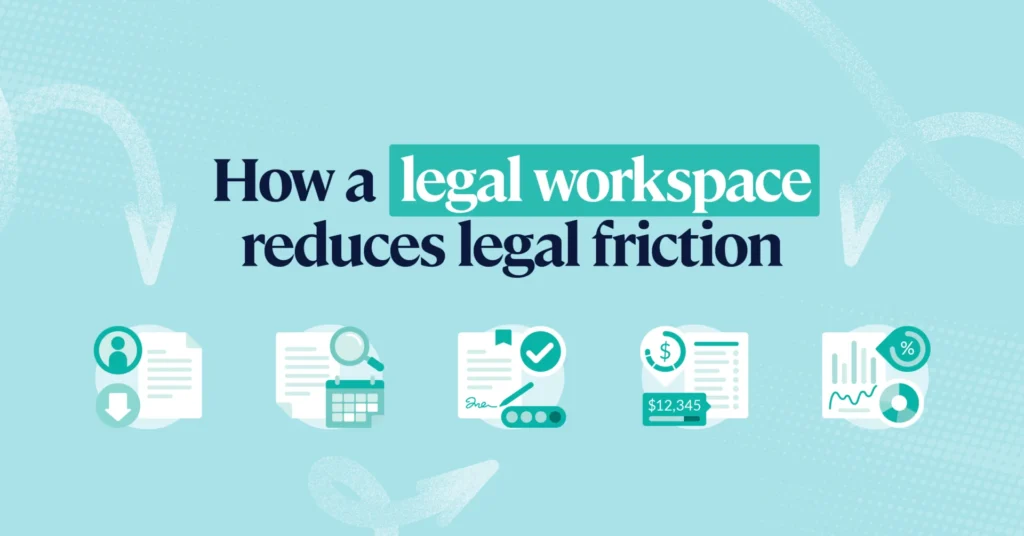Legal friction: Overcoming the hidden roadblock to scalable legal operations

What you’re facing isn’t just inefficiency. It’s legal friction. And by understanding what it is, you can take the right steps to overcome it.
If you’re a legal operations leader, chances are you’re already knee-deep in optimizing processes, managing tech, and finding new ways to do more with less. But if it’s taking longer than you’d like to make measurable progress and legal is still struggling to shake its reputation as a bottleneck, it’s time to look beneath the surface to see what’s really going on.
What is legal friction?
Legal friction is the unnecessary drag that slows down legal teams and the business. It shows up as manual work, repetitive tasks, unclear intake, fragmented tools, and clunky workflows. It’s present in both legal team work and in critical interactions between legal and the wider business. It’s not just frustrating, it’s costly.
According to recent research from IDC, legal friction is directly undermining the ability of legal teams to operate strategically, deliver timely service, and maximize value to the broader business. Importantly, this research not only gives a name to the problem, it substantiates its impact with numbers – which as a legal operations professional, you can use to your advantage.
It’s worth noting that the IDC survey polled both legal teams and business leaders across industries and countries in order to create a holistic view of how legal workflows affect entire businesses. Here are some of the key takeaways from the research that legal operations should consider:
- Legal friction has a negative impact on the business’s bottom line: IDC’s research shows that legal inefficiency and fragmented workflows lead to lost and delayed revenue, quantifiable productivity loss, and unnecessary outside counsel spend.
- Legal friction impacts brand, reputation, and risk too: Business teams report receiving customer complaints due to delays caused by legal processes. Some also admit bypassing internal legal processes altogether, increasing organizational risk.
- Legal friction is present in interactions between legal and the business: Scattered communications and a lack of data, self service, and visibility top the list of pain points in daily interactions reported by both legal teams and their businesses.
- Legal operations principles and legal technology are a proven solution when implemented well: The research shows that when businesses adopt legal technology they achieve great outcomes, including higher efficiency, revenue gains, and greater confidence in the legal team.
Armed with this information, legal operations leaders can better lead the charge for technology investment and adoption as well as reinforce the potential of effective legal operations. Pro tip: use this infographic as a tool to calculate the cost of legal friction to your business:
Click here to download your free copy of the IDC white paper.
Why legal operations should care about legal friction
As the engine behind legal efficiency, legal operations leaders are uniquely positioned to address legal friction head-on. Here’s how understanding and addressing legal friction can directly support your operational goals:
1. Diagnose the root cause of the problem
Legal friction gives you a language and framework for what’s really slowing the legal team down. With substantial evidence that manual tasks, administrative overhead, and ineffective business interactions reduce productivity, the research will help you explain why solving systemic issues that create friction (such as poor workflow design, lack of automation, or tool overload) will not only deliver real relief to legal, it’ll also align with business objectives.
2.Use data to drive change
The IDC research quantifies the impact of legal friction in terms that the business will respond to: loss of productivity and loss of revenue. Responses to the survey indicate that:
- Around 11 percent of revenue generation* has been lost or delayed in the past 12 months due to inefficient legal processes, representing an estimated USD $141 million per enterprise.
- Legal inefficiencies force enterprises to outsource approximately one-sixth (16.5 percent) of their legal work unnecessarily, incurring avoidable costs that could lead to a potential savings of USD $350,000 per organization.
- Inefficiencies lead to the equivalent of USD $299,520 in legal team time wasted annually.
*For businesses surveyed with mean revenue of over USD $1 billion per annum With these insights, legal operations leaders can do two things:
- Build a stronger business case for investment in people, process, and technology; and
- Drive greater adoption of legal technology which is already in place by reinforcing the positive business impacts of strong adoption.
3. Elevate legal’s reputation
Legal friction isn’t just slowing legal down – it’s hurting the way that the business perceives the department. The IDC research shows that only 21 percent of business leaders believe legal is “very effective” at supporting their department in achieving business objectives, while 70 percent admit to bypassing legal altogether. When asked about pain points in their interactions, both legal and the business point to a lack of self service, scattered communications, and poor visibility as key culprits of inefficiency and legal friction.
This data gives you a way to translate the issues you are experiencing within your legal department workflows into a language that your business cares about. And you can use that to your advantage:
- The IDC research is an easy point of reference for showing that legal is concerned about how businesses experience their services. Consider using it as a starting point for seeking feedback from your organization, and as a benchmark for improving interactions between legal and your business.
- You can prioritize solving for these pain points in your approach to technology and operations, knowing that it will have a high impact.
- You can then use the IDC data to support the change management that will drive the adoption of said solutions. It’s a clear way to show the “why” and “what’s in it for us” that is critical for effective change management.
This will not only result in saving legal department time, but it will also transform service delivery and solidify legal’s reputation as an enabling function and strategic business partner.
4. Maximize ROI from legal technology
While the IDC research highlights how impactful legal technology can be when it is in place, it also shows that some of the biggest causes of legal friction are fragmented tools that don’t talk to each other. For legal operations professionals, these data points can easily become a call to action: from making the case for consolidating legal technology into a time-saving unified workspace to identifying critical integrations and leveraging data for continuous improvement.
5. Deliver scalable legal services
Legal friction makes scale impossible, and the IDC data shows that the situation is likely to get worse without investment in legal operations:
- Only 37 percent of legal teams believe they have the resources to keep up with business demand.
- 71 percent of business leaders believe that technology and process improvement are required for the legal function to scale and meet future growth demands.
Using this information can help you speak to the urgency of acting now. Show your business how smarter intake processes, automated workflows, and centralized legal tools can help the legal team handle more work with less effort – without sacrificing quality or control.
How to use the IDC data for legal operations
IDC’s research isn’t just informative – it’s a tool you can use to:
- Show business stakeholders why legal deserves investment – now.
- Prioritize high-impact areas for process and tech improvements.
- Drive greater technology adoption and ROI.
- Equip leadership with a clear picture of how legal friction affects enterprise-wide performance, and the ways in which legal operations can reduce it.
Legal friction isn’t just a legal team problem – it’s a business problem. And legal operations is the key to solving it. By understanding the root causes of legal friction and using data such as that gathered by IDC white paper to drive action, legal operations leaders can overcome their roadblocks, scale service delivery, and finally turn legal into the high-performing, strategic function it’s meant to be.
Click here to learn more about legal friction or, click here to learn more about the five ways a legal workspace can reduce legal friction for your business.

From friction to force multiplier
With practical tips on evaluating and adopting legal tech. Hear from industry experts and learn how modern legal teams use tech to reduce friction and drive better business outcomes.




